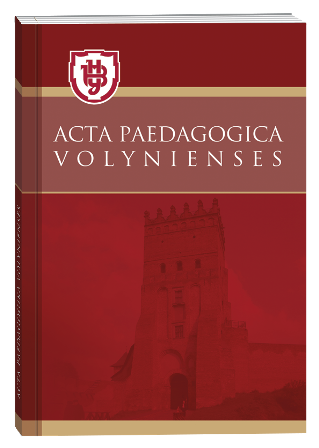CHARACTERISTICS OF THE MUSCULAR SYSTEM IN PRIMARY SCHOOL CHILDREN WITH DIFFERENT LEVELS OF PHYSICAL HEALTH
DOI:
https://doi.org/10.32782/apv/2023.5.7Keywords:
hand muscle strength, physical health, school-age children, hand dynamometry, standing dynamometry, anthropometric indicatorsAbstract
The investigation of hand muscle strength in children with varying levels of physical health is relevant in the context of increasing attention to the overall physical development of children. Exploring this topic allows for adapting physical programs to promote their optimal development and instilling a positive attitude toward physical activity. The research aims to study the possibilities of hand muscle strength in children with different levels of physical health. Objectives include defining the problem’s scope, analyzing hand muscle strength characteristics, and conducting a comparative analysis of indicators in children of different genders. The research holds significance for the physical, psychomotor, and social development of children. Methods employed include hand dynamometry, standing dynamometry, and mathematical statistics. The study was conducted at Rojysche Lyceum No. 4, involving 107 children aged 6–10 years. The analysis of results revealed a statistically significant difference between hand and standing dynamometry values in children of different ages. It is hypothesized that regular physical exercises aimed at developing strength abilities significantly influence biochemical, morphological, and physiological processes in the body. The comparative analysis of hand muscle strength indicators in children of different genders uncovered certain differences in muscle development between boys and girls. The results indicate that, on average, boys exhibited greater hand muscle strength compared to girls, possibly due to physiological differences in muscle development. Determining hand muscle strength is crucial not only for predicting the physical work capacity of schoolchildren but also for practical use in timely forecasting the feasibility of additional physical education activities based on physical data. This allows children at early stages of physical exercises to assess their physical performance, guide them, draw attention to the peculiarities of their subsequent physical development, and develop specific recommendations for improvement.
References
Власюк, О. О. (2022). Самостійні заняття фізичними вправами як засіб розвитку рухових якостей дітей молодшого шкільного віку. In The 6th International scientific and practical conference «Multidisciplinary scientific notes. Theory, history and practice» (November 01–04, 2022) Edmonton, Canada. International Science Group. 2022. P. 468.
Вовканич, Л., Гриньків, М., Куцериб, Т., & Крась, С. (2015). Роль морфологічних чинників у визначення сили ізометричного скорочення м’язів-згиначів пальців кисті. Спортивна наука України, (3), 3–8.
Гламазда Н. О., Гордійчук В. І. (2023). Особливості м’язової сили кистей у дітей з різним рівнем фізичного здоров’я. VІІ Міжнародна науково-практична конференція молодих учених, студентів та аспірантів «Актуальні проблеми розвитку природничих та гуманітарних наук» (Луцьк, ВНУ імені Лесі Українки, 10 листопада 2023 року). 53–55.
Петрусенко, О. (2021). Особливості рівня розвитку сили у школярів з розладами аутичного спектра. Актуальні проблеми фізичного виховання різних верств населення, 122–126.
Щапова, А. Ю., & Шульга, І. О. (2022). Оцінка функціонального стану організму дітей 10–17 років із різним характером фізичного навантаження. Актуальні проблеми громадського здоров’я: матеріали XІІ міжнародної науково-практичної конференції «Освіта і здоров’я». Суми : СумДПУ імені А С. Макаренка, 117–121.
Ярмак, О. М., Трофіменко, В. О., Марченко, О. Ю., & Мартин, П. М. (2023). Особливості морфофункціонального стану підлітків з дефіцитом маси тіла. Rehabilitation and Recreation, (15), 193–201.
Bendíková, E. (2022). Functional Disorders of the Musculoskeletal System in Younger School-age Pupils. Physical Education and Physical Activities of Children, Youth and Adults and Healthy Active Living Researches–Best Practices–Situation, Bratislava. 183–194.
Boguszewski, D., Stępień, M., & Adamczyk, J. G. (2023). The influence of core stability exercises programme on the functional limitations of the musculoskeletal system in girls practising volleyball. Physical Activity Review, 11(1). 24.
Geng, Y., Trachuk, S., Ma, X. M., Shi, Y. J., & Zeng, X. (2023). Physiological features of musculoskeletal system formation of adolescents under the influence of directed physical training. Physical Activity and Health, 7(1). 1–12. DOI: 10.5334/paah.217
Purushe, D., Dhage, P., Padole, D., Phansopkar, P., Chitale, N., & Wadhokar, O. C. (2021). A review on musculoskeletal screening in girls and boys aged between 5 and 12 years. J Med Pharm Allied Sci, 10, 3120–4.
Valina, S. L., Shtina, I. Е., Maklakova О.А, U. О., & Eisfeld, D. A. (2021). Regularities in diseases of the musculoskeletal system developing in schoolchildren under complex exposure to environmental factors and factors related to lifestyle. Health Risk Analysis, 3, 54–66.
Yu, M., Li, G., Jiang, D., Jiang, G., Tao, B., & Chen, D. (2019). Hand medical monitoring system based on machine learning and optimal EMG feature set. Personal and Ubiquitous Computing, 1–17.







